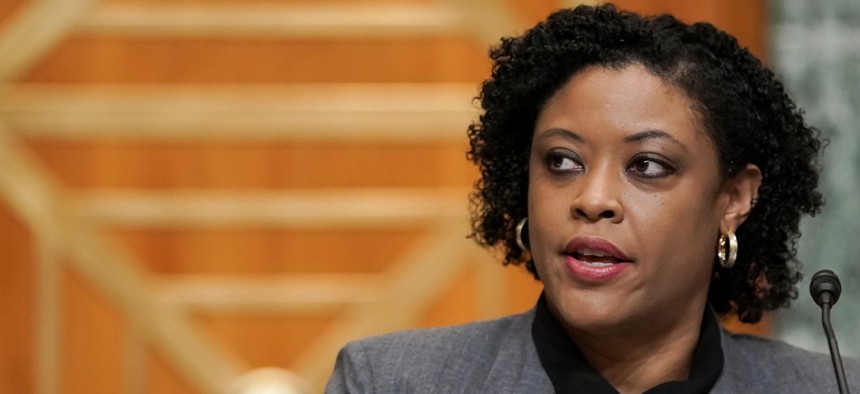
Office of Management and Budget acting Director Shalanda Young testifies on Capitol Hill in June. Greg Nash/Pool via AP
OMB: Agency Equity Metrics a Work in Progress, Services Too Burdensome for Disadvantaged Groups
Acting OMB Director Shalanda Young described the measurement of equitable service as a “nascent” field, in need of constant development and review.
The Office of Management and Budget last week reported that agencies need to do more to ensure that their processes do not make government services inaccessible to underserved groups, as well as to continue to develop mechanisms for measuring equity.
The report, prompted by President Biden’s Jan. 20 executive order promoting equity in federal programs and rescinding former President Trump’s ban on some forms of diversity and inclusion training at agencies and federal contractors, also says that agencies must expand their engagement with the public to ensure a diverse range of people may weigh in on policy decisions before they are finalized.
In an article posted to the White House’s website, acting OMB Director Shalanda Young said agencies need to take a hard look at the “administrative burden”—including in-person appointments, navigating complex programs and websites, and collecting and supplying eligibility documentation—that people must traverse to access a government service to ensure equal access, particularly for underserved groups.
“Research indicates that where there are administrative burdens, they do not fall equally on all entities and individuals and can lead to the underutilization of critical services, often by the people and communities who need them the most,” Young wrote. “Our report suggests that when agencies work to mitigate administrative burden, their efforts can significantly enhance their ability to comprehensively advance equity, meet the needs of underserved communities and improve operational efficiencies.”
Although agencies were required to complete their own reviews of equity in federal programs by Aug. 8, Young described equity assessments as a “growing though still nascent” field of study that will require the development and cross-reference of a variety of tools.
“Collectively, much of the work rests on key principles that appear in different forms across different frameworks,” the report states. “These principles include the importance of understanding the history of disparities in the United States; perceiving the legacy of those disparities in public processes; and cultivating detailed awareness of populations that have been affected by past, as well as current, disparities . . . Equity experts recommend gaining this knowledge by ensuring that diverse perceptions and insights are included throughout the policy process, including when policies are designed, implemented, managed and evaluated.”
OMB’s report highlights three “common barriers” agencies typically face when conducting equity assessments: underutilized data, where agencies may have data, but there are barriers that prevent it from being used effectively; inaccessible data, where information can’t be used because it could compromise people’s privacy; and missing data.
“In some cases, data needed to answer a question or respond to an issue do not exist at all or currently only exist at a very low quantity,” the report states. “[In] other instances, federal program applicants have not traditionally asked about demographic characteristics that are not necessary for deciding program eligibility in order to reduce the perception of discrimination . . . This is also another potent reminder that technical tools for data collection and protection must be deployed in combination with community understanding to advance equity.”
Young also said that agencies need to improve opportunities for members of the public can weigh in on proposed regulations and other policy initiatives to make them more accessible.
“Many federal agencies already conduct stakeholder engagement, including notice-and-comment sessions and town halls,” she wrote. “However, these efforts are too often perceived by stakeholders and agencies alike as being siloed, inaccessible, or without clear purpose. By adopting more accessible mechanisms and elevating new voices earlier on in the process, agencies are better positioned for co-designing meaningful and effective programs and services while reaching more underserved communities and customers.”







